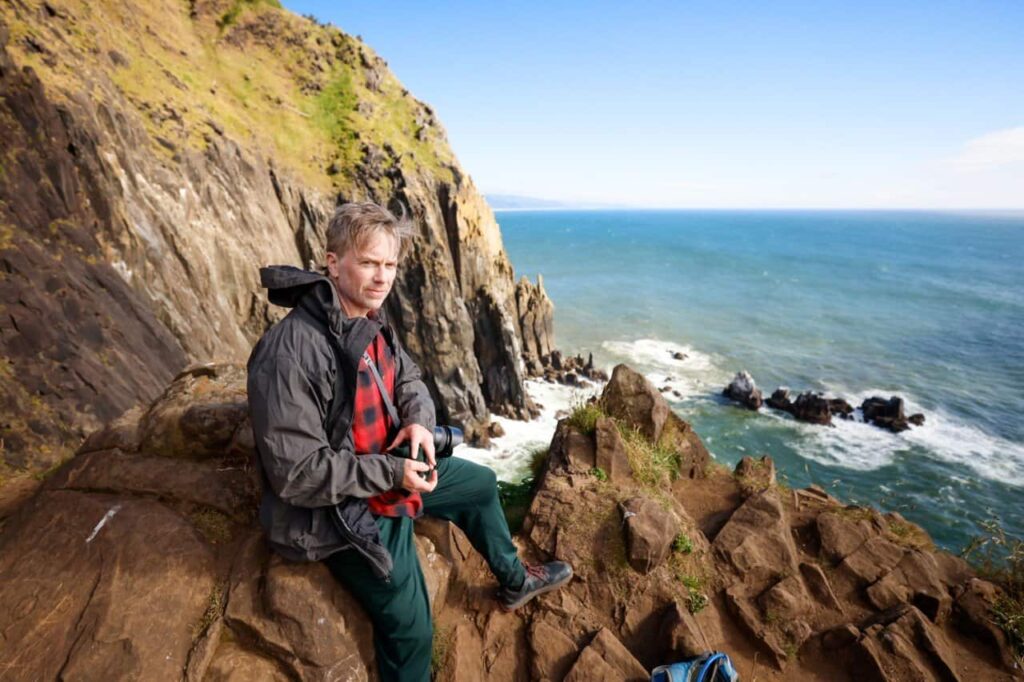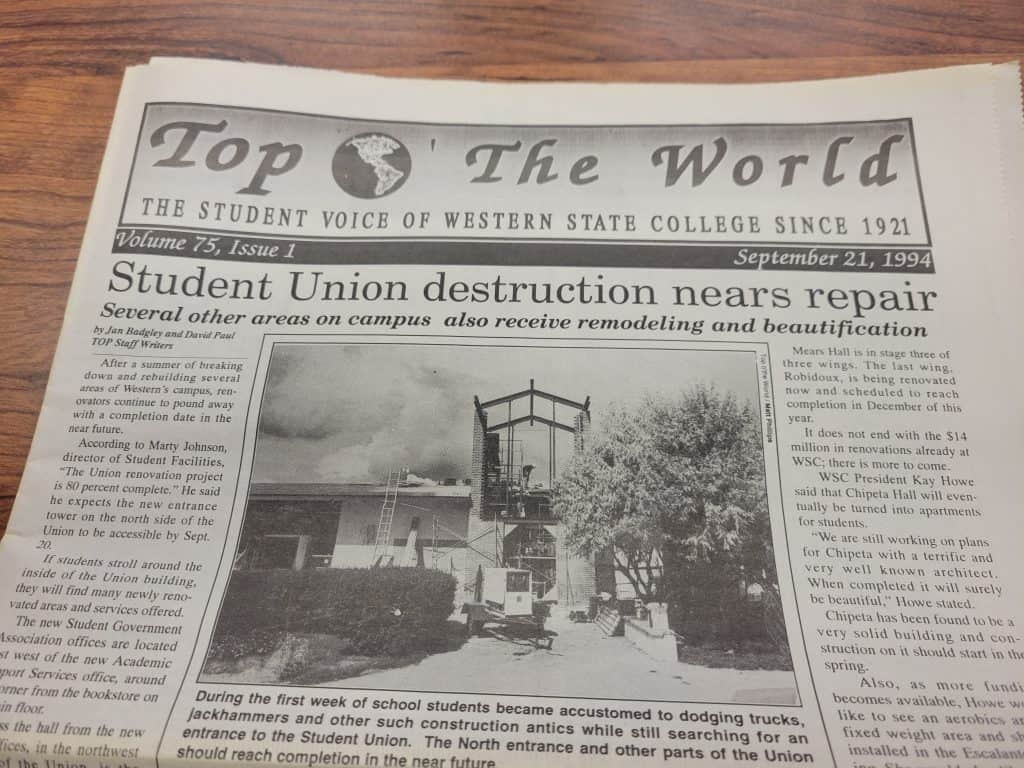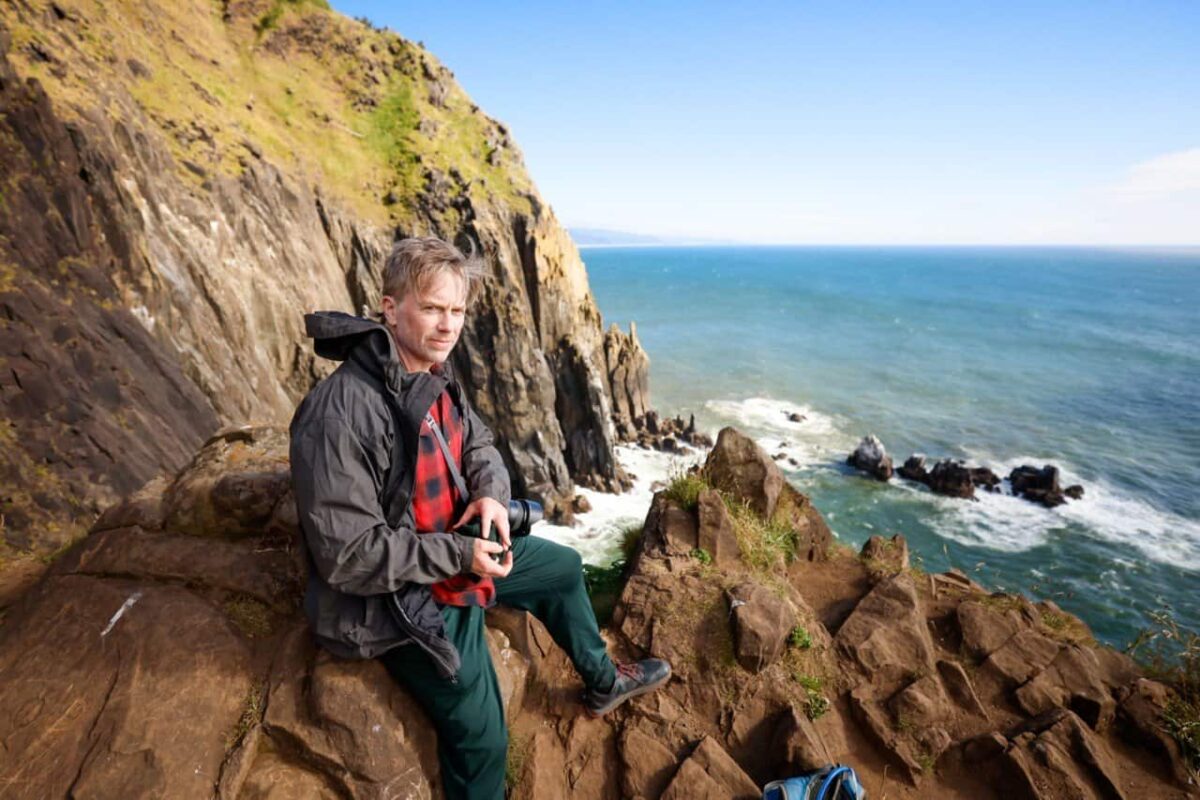
“We spent insane hours over there…I would get a 32 oz. soda at the Taco Bell and then we would just stay up all night trying to finish the thing,” remembers Keith Carlsen, Top o’ the World’s editor during the 1994-1995 academic year, of the evenings before printings. “It was really just sleepless nights to get this thing done.”
Carlsen first came to Western, then known as Western State College, with the goal of establishing residency in Colorado and transferring to the University of Colorado-Boulder.
But his involvement with Top o’ the World, which began almost immediately his freshman year, convinced him to remain a Mountaineer.
Finding his calling
More than any particular story, Carlsen remembers the internal politics of it all — hiring, managing, and disciplining a team while in his early 20s.
“We took it very seriously, and it was way more important to me than my classes,” he adds. “We really prided ourself on the [paper] being something that people cared about.”
At the time, Carlsen recalls a student newspaper that was humming along smoothly — and attracting a solid readership — in a pre-internet age. Staff photographers used darkrooms and email was a newfound, seldom-used technology, even in Carlsen’s upperclassmen years.
“It was well-balanced. We were trying to create a real newspaper that had a front page story, sports, outdoor, and that had an opinion [section] — we even had cartoons, we had a staff cartoonist who would do political stuff,” remembers Carlsen. “We also had very active sports coverage…we actually wrote about the volleyball games.”
Back then, Top o’ the World was advised by Mark Todd — an emeritus English professor at Western for more than three decades, as well as a freelance writer, novelist, and poet. Todd retired from teaching in 2020.
“He was an absolutely incredible person, and he gave me every direction [I have] in my life,” notes Carlsen of Todd. “He’s the reason why the journalism program existed.”
From the very start, Carlsen was predominantly drawn to photography, but was told that the newspaper was so small that he would have to write the stories to accompany his photographs.
His first assignment was to venture out to the edge of town and take photos of a crashed Jeep belonging to a Western fraternity member — the result of an alcohol-related incident.
Carlsen recalls riding his bike out to the crash site, and writing up the story on the incident.
“They published it on the front page. I’ve barely been at school for a month or two at that time. Then the guy [featured in the story] called me up and was threatening me — that was my first story.”
Assuming the helm
From the beginning, Carlsen says he took his duties with Top more seriously than his peers. He believes that weight he brought to the newspaper was the result of his core personality — shaped by early childhood hardship with the passing of his father — that pushed him to strive for greatness, and lead others to do the same.
“I didn’t know I was a leader or a manager until this job. It really showed me I could lead people, but I had no idea I could do that, which made it so special,” says Carlsen. “It showed me myself. It helped me reveal and understand who I was in young adulthood more than anything else I did.”
His underlying passion for storytelling and media would later spur him to undertake a media career that has lasted more than two decades.
Carlsen declared as a communications major with a journalism emphasis, and continued churning out stories. He rose to the position of sports editor his sophomore year, before assuming managing editor duties during his junior campaign.
Back then, CoPIRG, the Colorado Public Interest Research Group, had an active student chapter which consistently raised everyday environmental issues like recycling —and early efforts at wolf reintroduction — to the forefront on a weekly basis.
Additionally, the AIDS crisis, raging at the time, claimed 100,000 American lives in 1994-95, and captured headlines in Top’s weekly editions.
“I remember that they really tried to scare young people…it was really intense back then,,” Carlsen remembers, recalling the popular slogan offered to young adults: “don’t just do it.”
Even back thirty years ago, housing was a substantive issue that garnered media attention — with dramatic, carefully researched stories quoting then-mayor Jim Gelwicks of students sleeping on couches and in basements appearing across Top’s front page.
“We were given the opportunity to have journalistic integrity with our [sponsoring] institution, and I don’t know if that really happens anymore,” offers Carlsen, who points to one story with the headline “Student Union destruction nears repair,” as a prime example of Top’s staff exerting the paper’s cheeky style within the context of substantive journalistic coverage.

Dispensing editorial wisdom
In his role as managing editor, Carlsen published a weekly column entitled “Notes from the chief,” where he kept readers abreast of campus happenings.
One such note, from 1994, dove into a phenomenon that Carlsen termed “pseudo hippies,” with a headline captioned “Pseudo-hippies have no place in society.”
In the piece, Carlsen offers, “Wannabe beatnik, contradictory environmentalists are the most annoying social group on this planet. Where did they come from, and who allowed them to stay here? In case they haven’t noticed, this is 1994. The 60s, real hippies and the one and only real Woodstock are done and gone.”
“But hey, they claim to be the last of the ‘true environmentalists.’ It is amazing how these greeny greats also smoke cigarettes and drive their cars to and from school (usually only several blocks),” Carlsen continues later in the letter.
“We were very anti-car, and we were very much about biking everywhere. We biked all winter, [including] in the freezing cold,” recalls Carlsen. “We had a lot of attitude.”
His final week as editor, Carlsen published one last note, in which he wrote, “Being the managing editor of this publication has taught me more than I ever wanted to know about Western State, the students that fill its classrooms, life in general and myself.”
Life after Top
During his senior year at Western, Carlsen went on to do freelance work for the Gunnison Country Times (GCT), where he covered a wide range of events and stories that allowed him to flex his burgeoning photography skills — including a Fourth of July photo essay, and coverage of the local skiing and mountain biking scene.
After graduation, Carlsen took an internship with Powder Magazine, and soon rose to become the youngest-ever editor of Powder Magazine at age 24.
“I think that’s a really cool testament to how I came out of Western — I was prepared,” he adds.
Carlsen says that his tenure at Western and GCT perfectly coincided with the rise of competitive extreme skiing in Crested Butte — Carlsen entered Western in 1992, the same year the U.S. Extreme Skiing Championships started. That coincidence positioned him favorably to go on to work for Powder.
“Crested Butte’s famous in the U.S. Extreme Skiing Championships, and that is people [ski] jumping off of cliffs,” says Carlsen. “It was really Crested Butte and Alaska, those were the two places this thing was happening.”
Nowadays, Carlsen owns his own media company that he founded back in 2001, Keith Carlsen Productions. With his company, Carlsen undertakes a wide swath of storytelling projects that blend his talents in photography, writing and editing, and production.
From Carlsen’s bio on his company website: “I’m fascinated by the relationship between subject and photographer and pride myself on my ability to connect with whomever I’m photographing, establishing trust and allowing their strength and vulnerability to shine through.”
Reminiscing on his Western days, Carlsen gives a good share of the credit to Top o’ the World for cultivating his interest in media, and for preparing him with the skills he needed to forge a multimedia career that has seen him work around the globe for a diverse host of clients.
“It was what mattered [to me]. I was really driven to get published and to see my name in print and make this thing, and to really make it something great,” he says, adding later, “We really tried to be a truth telling source.”
Not only was Top a vessel for Carlsen to launch his own career — it helped launch others on Carlsen’s staff during the 1994-95 year — including Adam Howard, the current CEO of Height of Land Publications, which owns Backcountry Magazine.
Beyond its utility as a training ground for future media professionals, Top was also an outlet for young adults to navigate and hone their opinions about the world.
“There were no filters then because we didn’t know any better and we didn’t know any different. At that age, you just want to speak your mind — and [Top] gave us a voice,” says Carlsen. “There was no social media, but we had a platform to speak to the world, and I think that was really attractive.”

